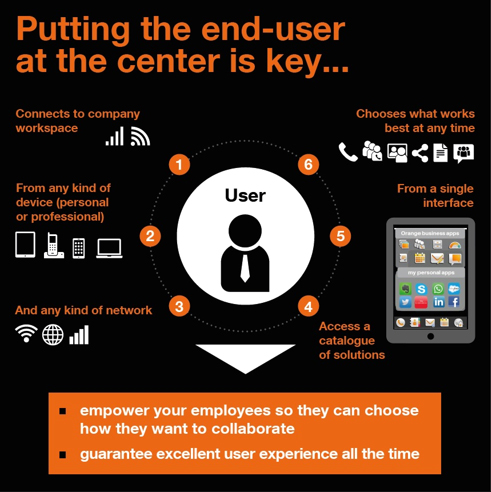The modern workplace is a hotbed of collaboration. Workers who are so used to using social media, instant messaging apps and sharing tools in their daily lives know that these methods save them time and make them more efficient – as well as making them better, more effective communicators. So it is not surprising that Unified Communications (UC) has become so central to work – and to business.
UC today has become more than ‘just’ a communication mechanism – that image of UC is now very much out of date. We are in fact talking about Unified Communications and Collaboration suites, or UC&C – which has evolved into being the most vital tool for business collaboration around today. A full UC&C suite provides all the business-critical tools and services needed to communicate and collaborate, enabling a smoother workflow and better engagement between teams and people in the organization.
The focus, then, is on how to realise the most value out of UC&C, to enable your teams and people to work smarter and more effectively and to be more productive.
Central to this is a successful UC&C deployment, which very much depends on your approach to it – essentially how UC (you see) it. Here I would like to suggest we take an approach that looks at UC&C from the end-user point of view.
The changing philosophy
The focus of any UC&C deployment should be very much determined by the end-user experience. Your workers select many different apps in their personal lives based on how they fit into their needs and workstyles, and expect to get a great end-user experience from them. So, naturally, they expect a similar degree of experience with UC&C in the workplace.
With that in mind, it is advisable to tailor your UC&C suite to your users’ habits. Rather than trying to force users to adapt their communication and collaboration styles, identify the type of end-user experience they want and then deploy a UC&C suite to deliver that – it is the UC&C suite that should be adapted to user habits and practices, not vice versa.
Beyond adapting to user habits and practices, your UC&C suite should also be able to adapt to the ever-evolving digital workspace, for example, to support new mobile devices, and to scale to your needs as well as support different geographies and languages. In other words, it must deliver a great end-user experience both now and into the future.

A great end-user experience through a tailored approach to your UC&C suite encourages greater adoption of the UC&C tools, which subsequently benefits your business. This is the virtuous circle nature of UC&C – the better the suite and services you give your workers, the more they use them to their and your organization’s benefit and the more they will want to use them.
Types of implementation
Traditionally, UC&C deployments followed the on-premise model, but that has changed over time – more options exist now. The basic on-premise UC&C suite still makes sense to large organizations with 10,000 or more users, and who would also have business-critical apps like CRM and ERP on premise. It is also more suitable in environments requiring a high degree of customization and integration with third-party or in-house apps, and in vertical industries where regulatory compliance demand it. An on-premise UC&C suite can leverage existing investments in hardware and software for UC, and can potentially offer a lower total cost of ownership (TCO) over the long term.
In time, UC&C shifted to a cloud-based deployment, offering new opportunities and addressing some of the limitations of the on-premise approach. UC&C in the cloud standardizes the UC&C tools for all users – this seamless, uniform model is very attractive to organizations with users spread across a global footprint that are highly reliant on collaboration. Cloud-based UC&C is most suitable for organizations with around 1,000 to 8,000 users or so, and its on-demand OPEX-based model means organizations only pay for what they use – giving the benefit of financial flexibility. It is also well-suited to companies for whom time to market is key, offering a more agile deployment of UC&C compared to on-premise. For smaller and medium-sized organizations where resources are limited, cloud-based UC&C makes a lot of sense.
But there is no reason to believe that you must choose between on-premise and cloud, that you must choose one to the exclusion of the other. A third way exists – the hybrid approach. The hybrid UC&C model combines elements of the two and organizations can pick and choose what works best for them. You can have a hybrid UC&C model based on location, where major campus or country locations could be on-premise and remote branch offices could be cloud-based. You can also have it based on functionality, where business-critical and custom apps could be on-premise but call control, voicemail, presence and the like could be cloud-based.
Remember that on-premise solutions may involve large CAPEX investments while cloud solutions may represent long-term subscription contracts – and make the choice that is right for your needs.
Ensuring successful implementation
To make sure your UC&C deployment is successful you of course need to allocate sufficient time and resources to the initiative – and by planning strategically, you can achieve a smoother adoption and faster time to benefits.
A good way to do this is to make yourself a checklist or roadmap – this helps because UC is a journey, not a one-off decision where you just buy a product and install it. You can start by asking yourself a series of questions:
- Why are you beginning a UC journey and what do you expect to achieve?
- Which departments will you deploy UC&C to first, and then which departments after that?
- What is your timeline for delivery?
- How do you intend to measure success?
Another good way is to learn from the Forrester report ‘Define Business Value in Collaboration’, which provides insights on how to deploy UC&C successfully and get the best value from it – and also how you can drive and measure hard dollar savings from UC&C.
Making the right choices is vital. Just as you have to choose the right UC&C suite and the appropriate implementation model, you also need to choose the right UC solutions provider to work with – someone like Orange, with extensive experience in helping organizations deploy UC. How UC it really does matter!

